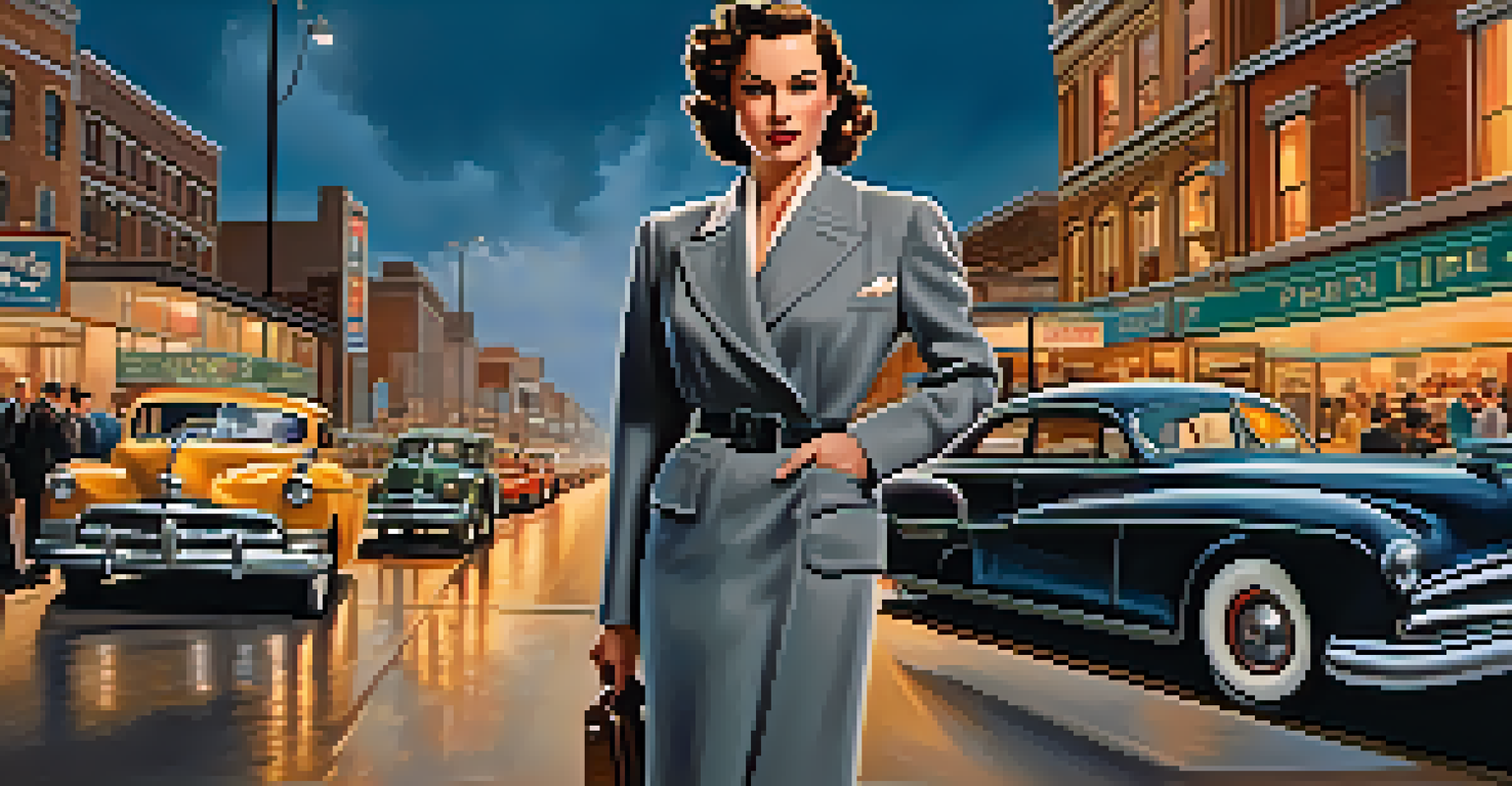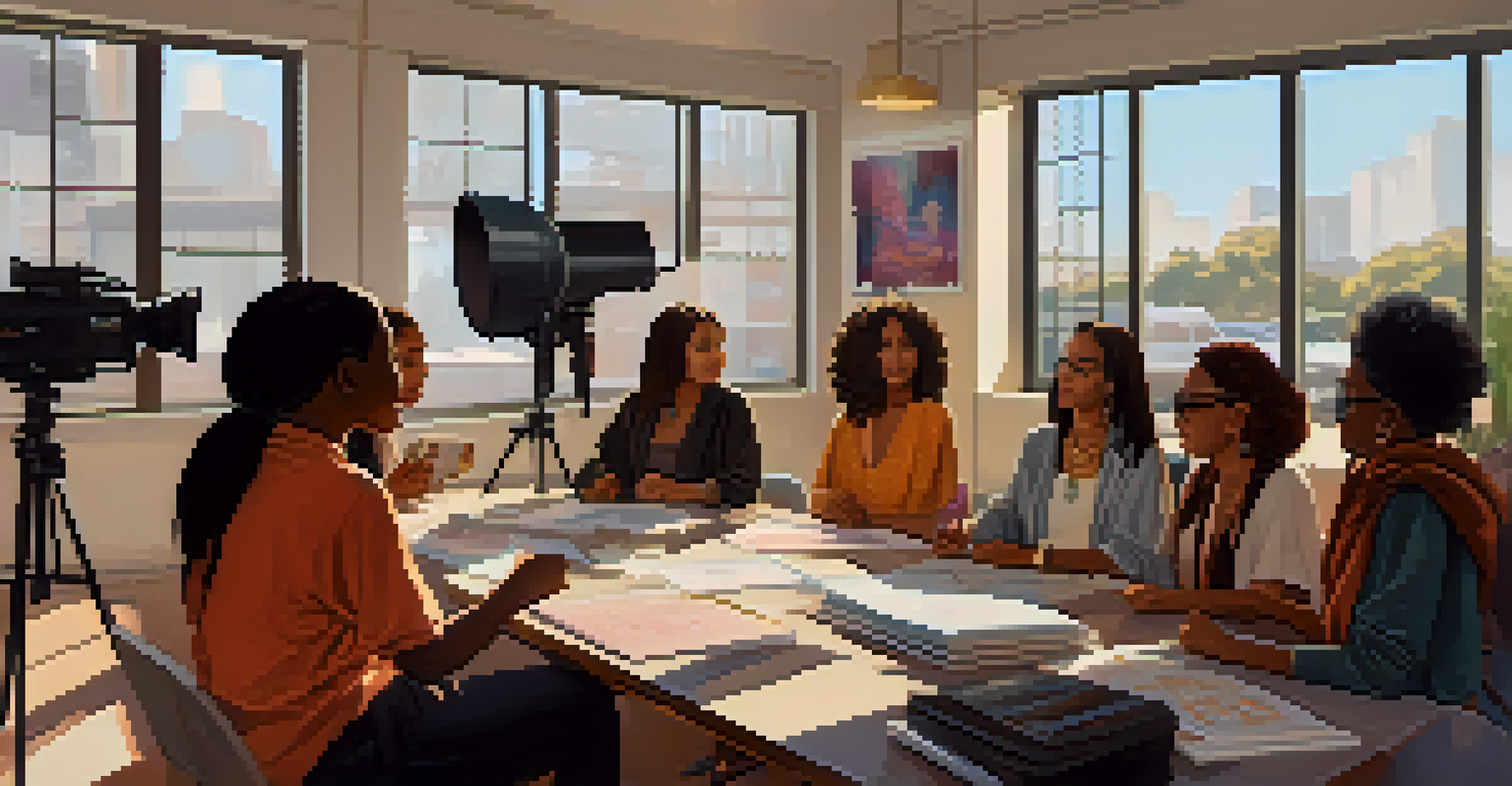The Evolution of Women's Roles in Hollywood Through Decades

The Silent Era: Women as Icons of Innocence
During the Silent Era, women in Hollywood often played the roles of damsels, showcasing innocence and beauty. Actresses like Mary Pickford became symbols of purity and charm, captivating audiences without uttering a word. These roles, while glamorous, often limited women's representation to a narrow spectrum, focusing more on appearance than depth.
The future is female.
However, the silent film industry also allowed women to break into powerful positions. Many actresses took on roles as producers and directors, setting the stage for future generations. Their influence in shaping the early film landscape highlighted the potential for women to be more than just faces on the screen.
As the decade progressed, the emergence of 'vamps' like Theda Bara showed a shift towards more complex female characters. These women were portrayed as seductive and mysterious, challenging the traditional notions of femininity. This evolution hinted at the multifaceted nature of women's roles that would continue to develop in Hollywood.
The Golden Age: Rise of the Strong Female Lead
The Golden Age of Hollywood, spanning the 1930s to the 1950s, brought forth strong female leads who captivated audiences with their talent and complexity. Icons like Katharine Hepburn and Bette Davis broke away from the stereotype of submissive women, showcasing strength and independence in their roles. This era marked a turning point where women began to demand more substantial parts in films.

Despite the progress, these strong characters often faced challenges stemming from societal expectations. Films like 'All About Eve' and 'The Philadelphia Story' highlighted the struggles women faced in balancing career aspirations with personal relationships. The tension between ambition and traditional roles became a recurring theme, reflecting wider societal issues.
Evolution of Female Roles in Film
Hollywood has witnessed a significant transformation in women's roles, evolving from innocent damsels to complex, empowered characters.
As the industry evolved, so did the portrayal of women. The introduction of film noir brought about a new archetype: the femme fatale. These characters embodied both allure and danger, further diversifying the representation of women in cinema. This era laid the foundation for future narratives exploring women's complexities.
The 1960s and 1970s: The Feminist Movement's Influence
The 1960s and 1970s saw the rise of the feminist movement, significantly impacting women's roles in Hollywood. Films began to reflect the changing social landscape, with characters that challenged traditional gender norms. Movies like 'The Graduate' introduced women who were no longer content with passive roles, seeking independence and agency.
There is no limit to what we, as women, can accomplish.
This period also saw the emergence of female filmmakers and screenwriters, such as Lina Wertmüller and Joan Didion, who brought fresh perspectives and stories to the silver screen. Their contributions emphasized the importance of women’s voices in storytelling, paving the way for future generations. The industry began to recognize the value of diverse narratives, acknowledging women's experiences beyond the confines of romance.
However, despite these advancements, Hollywood still grappled with stereotypes. Characters often oscillated between empowerment and objectification, reflecting the ongoing struggle for true equality. This duality highlighted the necessity for continued advocacy and representation in the film industry.
The 1980s: Complex Characters and Career Women
The 1980s introduced a new wave of complex female characters, often portrayed as career-oriented and independent. Films like 'Working Girl' showcased women navigating the corporate world, challenging the notion that success was solely a male domain. These stories resonated with audiences and reflected the shift in societal attitudes toward women's roles in the workforce.
However, this era also highlighted the tension between professional ambitions and personal lives. Many films echoed the struggles women faced in balancing their careers with societal expectations of marriage and family. This duality in storytelling revealed the ongoing challenges women encountered, even as they achieved new heights in their professional lives.
Impact of Feminism on Cinema
The feminist movement has played a crucial role in shaping narratives, leading to more diverse and independent female characters in films.
Moreover, as the decade progressed, women of color began to gain visibility in Hollywood, with figures like Whoopi Goldberg breaking barriers. Their presence not only enriched storytelling but also emphasized the importance of intersectionality in representation. The 1980s thus marked a significant step forward, though it also underscored the need for ongoing dialogue about diversity.
The 1990s: Challenges and Triumphs in Representation
The 1990s brought both challenges and triumphs in women's representation in Hollywood. While films like 'Thelma & Louise' celebrated female friendship and empowerment, others perpetuated stereotypes, often reducing women to romantic interests. This inconsistency showcased the ongoing struggle for authentic representation, as audiences craved diverse and multi-dimensional characters.
The decade also saw the rise of female-led franchises, exemplified by the 'Buffy the Vampire Slayer' series, which depicted strong, complex women battling societal issues alongside supernatural foes. This shift signaled a growing acceptance of women as protagonists in action-oriented narratives, challenging traditional gender roles in genre films.
Despite these advancements, many women in Hollywood still faced significant hurdles, including pay disparities and limited opportunities behind the camera. The disparity highlighted the need for systemic change within the industry, prompting discussions that would carry into the new millennium. The 1990s thus served as both a celebration of progress and a call to action for continued advocacy.
The 2000s: Diversity and the Rise of Female Filmmakers
The 2000s marked a turning point in Hollywood, with a growing emphasis on diversity and the rise of female filmmakers. Directors like Kathryn Bigelow and Sofia Coppola broke through the glass ceiling, bringing unique perspectives to mainstream cinema. Their success opened doors for a new generation of women in film, emphasizing the importance of representation behind the camera.
This era also saw a surge in films focusing on women's stories, ranging from dramas to comedies. Movies like 'Erin Brockovich' and 'Little Miss Sunshine' showcased women in diverse roles, challenging traditional narratives. These films resonated with audiences, proving that stories centered around women could achieve both critical and commercial success.
Ongoing Challenges in Representation
Despite progress, women in Hollywood continue to face challenges related to stereotypes, pay disparities, and the need for greater inclusivity.
Despite these advancements, issues of representation remained. Women of color and LGBTQ+ filmmakers still faced significant barriers, prompting calls for more inclusive practices within the industry. The 2000s laid the groundwork for ongoing discussions about diversity, emphasizing the need for continued progress in Hollywood.
The 2010s: Empowerment and the #MeToo Movement
The 2010s were marked by a significant cultural shift, with the #MeToo movement bringing issues of sexual harassment and gender inequality in Hollywood to the forefront. This movement galvanized women across the industry, leading to increased scrutiny of systemic issues and demanding accountability. The urgency of these discussions highlighted the importance of creating a safe and equitable environment for all.
As a result, audiences began to see a rise in films that addressed these themes, with stories focused on women's empowerment and resilience. Projects like 'Wonder Woman' and 'Lady Bird' not only celebrated female strength but also showcased the diverse experiences of women. This era reinforced the idea that women's stories are vital to the cinematic landscape, resonating with audiences around the globe.

However, while progress was evident, challenges remained. The industry grappled with backlash against these movements, revealing the complexities of navigating change. The 2010s, therefore, represented a crucial era of awakening and activism, setting the stage for ongoing conversations about representation and equality in Hollywood.
The 2020s and Beyond: A New Era of Representation
As we move into the 2020s, there's a palpable sense of optimism regarding women's roles in Hollywood. With a growing emphasis on authentic storytelling and diverse representation, filmmakers are increasingly telling stories that reflect the multifaceted experiences of women. Projects like 'Nomadland' and 'Promising Young Woman' showcase diverse female narratives, pushing boundaries and challenging conventions.
Moreover, the industry is witnessing a surge of female-led production companies and initiatives aimed at amplifying women's voices. This shift not only fosters creativity but also encourages collaboration and mentorship among women in the industry. As a result, we're beginning to see a more equitable landscape where women's stories are prioritized and celebrated.
Women Evolve from Icons to Leaders
Throughout Hollywood's history, women's roles have evolved from simplistic portrayals of innocence to complex characters and influential positions behind the camera.
However, it's essential to recognize that the journey is far from over. The continued fight for equality, representation, and respect within Hollywood is crucial. As audiences, we can support this movement by championing diverse stories and advocating for systemic change, ensuring that the evolution of women's roles in Hollywood continues to progress.